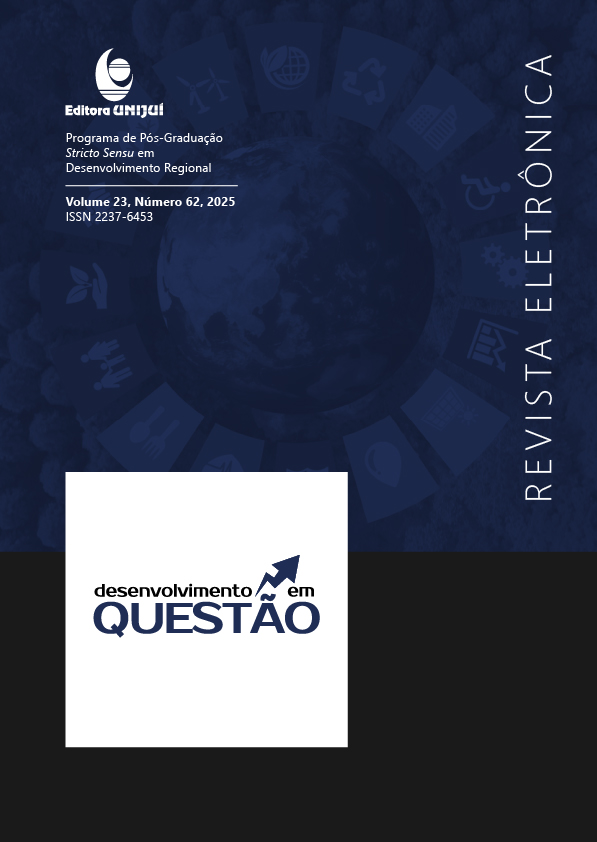Existirá alguma relação entre liberalização comercial e proteção social no Brasil?
DOI:
https://doi.org/10.21527/2237-6453.2025.62.15340Palavras-chave:
liberalização comercial, crescimento econômico, proteção socialResumo
Em um país em desenvolvimento como o Brasil, torna-se necessário analisar os aspectos econômicos e sociais que melhoram a qualidade de vida daqueles que vivem em situação de vulnerabilidade. O trabalho tem como objetivo analisar a relação de causalidade entre proteção social e liberalização comercial no Brasil. Para isso, são utilizados dados do Social Assistance, BRASIL/MDIC/ComexStat e Banco Mundial para os anos de 2004 a 2019, onde se analisam 67 países de renda baixa e média, através de painel dinâmico. Dentre os resultados obtidos, foi possível verificar que a variável população está diretamente relacionada a maiores gastos com proteção social, evidenciando que um maior contingente de pessoas em países desiguais tem maior necessidade de gastos com proteção social. Também foi possível verificar através do modelo dinâmico que as importações estão associadas à ampliação de gastos em proteção social. Quanto à liberalização comercial, a revisão teórica indica que este pode ser um fator que em crescimento pode trazer malefícios para os países com maiores desigualdades de renda, no entanto, os resultados neste trabalho não foram conclusivos sobre o impacto nos gastos em proteção social. À guisa de conclusão, visando reduzir a desigualdade de renda e a taxa de pobreza através da proteção social, faz-se necessário a ampliação de políticas sociais que se ajustem às singularidades dos países.
Referências
ALDERMAN, H.; YEMTSOV, R. (2013). How can safety nets contribute to economic growth? The World Bank.
ARYEETEY, E.; W. (2015). Baah-Boateng. Understanding Ghana's growth success story and job creation challenges. WIDER Working Paper 140, Helsinki.
ATTANASIO, Orazio; GÓMEZ, Luciana; HEREDIA, Patricia; VÉLEZ, Carlos. (2025). The short-term impact of a conditional cash transfer programme on child health and nutrition in Colombia. The World Bank Economic Review, 19(3): 509-532.
BITLER, Marianne; HOYNES, Hilary W. (2016). The more things change, the more they stay the same? The safety net and poverty in the Great Recession. Journal of Economic Perspectives, 30(2): 23-50.
BLOFIELD, M.; LUSTIG, N.; TRASBERG, M. (2021). Social protection during the pandemic: Argentina, Brazil, Colombia, and Mexico (No. 104). Tulane University, Department of Economics.
DESAI, R.M.; RUDRA, N. (2018). Trade, poverty, and social protection in developing countries. European Journal of Political Economy. doi: 10.1016/j.ejpoleco.2018.08.008.
DESBORDES, R.; VAUDAY, J. (2007). The political influence of foreign firms in developing countries. Economics & Politics, 19(3), 421–451.
ECKARDT, S.D.; MISHRA; V.T.; Dinh. (2018). Vietnam’s manufacturing miracle: Lessons for developing countries. Future Development. The Brookings Institution, Washington, DC.
FISZBEIN, A., N. R. Schady, and F. H. Ferreira (2009). Conditional Cash Transfers: Reducing Present and Future Poverty. Washington, D.C.: World Bank.
FLIGENSPAN, F.B. et al. (2015). The Brazilian exports of labor-intensive goods in the 2000s: An analysis using the Constant Market Share Method. Economia. 16(1):128-144.
HUBER, E., T. MUSTILLO, AND J. D. STEPHENS (2008). Politics and social spending in Latin America. The Journal of Politics, 70(2), 420–436.
GERTLER, Paul J. (2004). Do conditional cash transfers improve child health? Evidence from PROGRESA’s control randomized experiment. American Economic Review: Papers and Proceedings, 94(2): 336-341.
GHANI, E.W.R.; KERR, A.; Segura. (2015). Informal tradables and the employment growth of Indian manufacturing. Policy Research Working Paper 7206. World Bank, Washington, DC.
GREENE, W. H. (2012). Econometric Analysis. 7. ed. Boston: Pearson Education.
GUILHERME, G.S.P. (2019). Liberalização comercial e mortalidade infantil: um estudo das microrregiões brasileiras. Universidade Federal de Pernambuco. Programa de Pós-Graduação em Economia (Dissertação de Mestrado).
INSTITUTO BRASILEIRO DE GEOGRAFIA E ESTATÍSTICA (IBGE). (2020). Síntese dos indicadores sociais: uma análise das condições de vida da população brasileira. Estudos & Pesquisas, 43.
INTERNATIONAL MONETARY FUND (FMI). (2021) Growth, Slowdown, Precarious Recovery. World Economic Outlook. Disponível em w.w.w.imf.org. Último acesso em 27 de abril de 2021.
IRWIN, Douglas A. (2020). Free trade under fire. In: Free Trade under Fire. Princeton University Press.
LOPEZ-CALVA, L. F.; E. ORTIZ-JUAREZ. (2014). A vulnerability approach to the definition of the middle class. Journal of Economic Inequality. 12(1):23-47.
MILLIGAN, Kevin; STABILE, Mark. (2009). Child benefits, maternal employment, and child well-being. Journal of Public Economics, 93(7-8): 1100-1115.
MOROZ, H. E. (2020). The Role of Social Protection in Building, Protecting, and Deploying Human Capital in the East Asia and Pacific Region. World Bank.
NOGUEIRA, A. R. R. (2021). Será que a abertura ao comércio internacional reduz a pobreza? Uma investigação a nível mundial entre 2002 e 2017.
PANAGARIYA, A. (2019). Free Trade and Prosperity: How Openness Helps the Developing Countries Grow Richer and Combat Poverty. New York: Oxford University Press.
PEROVA, Elizaveta; VAKIS, Renos. (2013). Improving the performance of conditional cash transfer programs: Evidence from a randomized experiment in Peru. World Bank Policy Research Working Paper.
QUINN, D., M. SCHINDLER, and A. M. Toyoda (2011). Assessing measures of financial openness and integration. IMF Economic Review, 59(3): 488-522.
REZENDE, F.C. (2008) Visões "rivais” sobre mudança estrutural e proteção social. Nova Economia 18(1):35-50.
SALLUM JR, B.; GOULART, J.O. (2016). O Estado brasileiro contemporâneo: liberalização econômica, política e sociedade nos governos FHC e Lula. Revista de Sociologia e Política 24(60):115-135.
SCHULTZ, T. Paul. (2004). School subsidies for the poor: evaluating the Mexican PROGRESA poverty program. Journal of Public Economics, 74(1): 199-250.
SUPIOT, A. (2019). Justiça social e liberalização internacional. DESC, 2(2):45-65.
TOPALOVA, P. (2007). Trade liberalization, poverty and inequality: Evidence from Indian districts, 1st ed., Chap. 7, pp. 241–290. University of Chicago.
TREND ECONOMY. Annual International Trade Statistics. Disponível em:www.trendeconomy.com. Último acesso em: 01/07/2020.
VO, T. T.; NGUYEN, D. X. (2021). Impact of trade liberalization on household welfare: an analysis using household exposure-to-trade indices. Social Indicators Research, 153(2), 503-531.
WILLIAMS, J. (2020). Literature scan on the economic effects of social protection expenditure.
WOOLDRIDGE, J. M. (2010). Introdução à Econometria: Uma abordagem moderna. 4ª Edição. São Paulo. Norte-Moderna.
WORLD TRADE ORGANIZATION E WORLD BANK GROUP. (2015). The Role of Trade in Ending Poverty, World Trade Organization, Geneva.
WRIGHT W. (2020), How trade openness can help to ‘deliver the poor and needy’, Institute of Economic Affairs.
Downloads
Publicado
Como Citar
Edição
Seção
Licença
Copyright (c) 2025 Cláudia Rafaela Alves Ferreira, Monaliza de Oliveira Ferreira

Este trabalho está licenciado sob uma licença Creative Commons Attribution 4.0 International License.
Ao publicar na Revista Desenvolvimento em Questão, os autores concordam com os seguintes termos:
Os trabalhos seguem a licença Creative Commons Atribuição 4.0 Internacional (CC BY 4.0), que permite:
Compartilhar — copiar e redistribuir o material em qualquer meio ou formato;
Adaptar — remixar, transformar e criar a partir do material para qualquer fim, inclusive comercial.
Essas permissões são irrevogáveis, desde que respeitados os seguintes termos:
Atribuição — Atribuição — os autores devem ser devidamente creditados, com link para a licença e indicação de eventuais alterações realizadas.
Sem restrições adicionais — não podem ser aplicadas condições legais ou tecnológicas que restrinjam o uso permitido pela licença.
Avisos:
A licença não se aplica a elementos em domínio público ou cobertos por exceções legais.
A licença não garante todos os direitos necessários para usos específicos (ex.: direitos de imagem, privacidade ou morais).
A revista não se responsabiliza pelas opiniões expressas nos artigos, que são de exclusiva responsabilidade dos autores. O Editor, com o apoio do Comitê Editorial, reserva-se o direito de sugerir ou solicitar modificações quando necessário.
Somente serão aceitos artigos científicos originais, com resultados de pesquisas de interesse que não tenham sido publicados nem submetidos simultaneamente a outro periódico com o mesmo objetivo.
A menção a marcas comerciais ou produtos específicos destina-se apenas à identificação, sem qualquer vínculo promocional por parte dos autores ou da revista.
Contrato de Licença (para artigos publicados a partir de 2025): Os autores mantêm os direitos autorais sobre seu artigo, e concedem a Revista Desenvolvimento em Questão o direito de primeira publicação.











